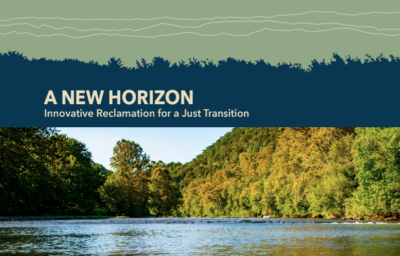Front Porch Blog

Communities across Appalachia are exploring ways to attract new investments, pull families out of poverty and develop skilled workforces by diversifying their economies. One of the key barriers to this transition is the thousands of coal-impacted sites that were abandoned and never cleaned up, and which now pose threats to public health and impede economic growth. Local leaders and entrepreneurs are working with great success to leverage the tremendous potential to repurpose these lands for innovative economic solutions that are specific to the culture, skills and geography of the Central Appalachian region.
The report can be found on the new website, ReclaimingAppalachia.org, which the Reclaiming Appalachia Coalition launched as a resource for all stakeholders, with information about abandoned mine lands, potential funding sources for reclamation, and other information.
Examples of the 19 projects
- Kentucky: Development of a 7,000-square-foot wellness center for the Pikeville Area Family YMCA, including a warm water aerobics and family pool, an outdoor splash pad, a sun deck patio and an improved parking lot. The YMCA sits below a now-remediated dangerous coal-waste slide that resulted from a historic mining operation. Cost: $865,000.
- Ohio: Restoration of the popular Moonville rail trail, including the construction of seven bridges, to improve access for pedestrians and bicyclists. Eight open mine portals will be remediated as part of the project. Cost: $2,071,100.
- Virginia: Comprehensive revitalization in Trammel, one of the oldest coal camp communities in Virginia, to improve housing and infrastructure. At least one open mine portal and a hazardous, abandoned company store will be remediated as part of the project, with the possibility of eventually remediating coal waste piles, clogged streams, additional portals and other coal features. Cost: $1,140,000.
- West Virginia: Development of the first commercial composting facility for organic waste in the region. Dangerous coal waste impoundments and water pollution will be remediated as part of the project. Cost: $3,335,000.
The Reclaiming Appalachia Coalition seeks to spur coal mine reclamation projects throughout Central Appalachia that are responsive to community needs and that accelerate the growth of new, sustainable economic sectors. The coalition consists of lead organizations in four states — Appalachian Voices in Virginia, Appalachian Citizens’ Law Center in Kentucky, Coalfield Development Corporation in West Virginia, and Rural Action in Ohio — and a regional technical expert, Downstream Strategies, based in West Virginia.
“Our coalition is very proud to work with local partners to support these projects that represent the innovation, creativity and drive of the region as we continue to re-imagine and work toward a future of sustainable and healthy local economies,” said Adam Wells, Regional Director of Community and Economic Development with Appalachian Voices.
“In Appalachian Ohio, we are turning pollution into a marketable product, and attracting thousands of visitors to experience the natural beauty our region has to offer. This work is timely and the investment in our communities is needed right now. Rural Action is proud to be a partner to the many communities and organizations supporting sustainable economic development in this region,” said Marissa Lautzenheiser, Watershed Coordinator with Rural Action.
The coalition’s report also describes key successes that the coalition has helped cultivate, including providing technical assistance to government entities and community organizations, supporting 28 communities in the four states with federal grant applications, and securing more than $15.8 million in federal Abandoned Mine Land (AML) Pilot funds and brownfields funding, leveraging approximately $11.4 million in additional funds.
“AML Pilot funding has inspired individuals and community organizations across Appalachia to begin thinking about how they can engage in the growing restoration economy. A person doesn’t have to be a mine land expert to recognize the vast potential that some of these sites have, and communities have been thinking about what to do with these sites for years. The Reclaiming Appalachia Coalition has provided critical technical capacity to lift up some of these deep-seated desires for these sites and get some projects on the ground,” said Joey James, Senior Strategist with Downstream Strategies.
In the past, efforts to reuse old mine sites too often resulted in sparse, lasting economic activity. Surface mined areas near population centers became shopping centers, hospitals and other standard uses, but more remote sites were either completely abandoned, converted to low-productivity cattle grazing lands, or developed into speculatively built industrial parks or golf courses at great taxpayer expense. Those “if you build it, they will come” projects now largely sit empty. To break from this unsuccessful approach to coal site reclamation, the Reclaiming Appalachia Coalition established six guiding principles to identify optimal repurposing projects, including ensuring they are appropriate to the place in which they are occurring, that they include non-traditional stakeholders in decision-making, and are environmentally sustainable and financially viable long-term.
Several recent federal initiatives have increased funding for redeveloping former mine and industrial sites for projects with sustainable economic and community benefits, including the AML Pilot program, which appropriated $105 million in 2017 and $115 million in both 2018 and 2019, and the Partnerships for Opportunity and Workforce and Economic Revitalization (POWER) program, which contributed $50 million to economic diversification in Central Appalachia. The RECLAIM Act, currently pending in Congress, would accelerate the distribution of $1 billion of existing funds over five years to revitalize coal communities.
The Reclaiming Appalachia Coalition and others continue advocating for passage of the RECLAIM Act and additional investment in the region where it is most urgently needed.
PREVIOUS
NEXT

Leave a comment
Your email address will not be published. Required fields are marked *

Leave a Comment